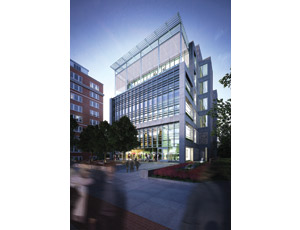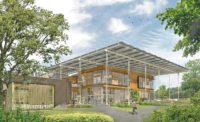In Atlanta green building circles these days, Ryan Gravel is a bit of a “rock star,” according to one co-worker at Perkins+Will. But he's not a “starchitect,” whose big reputation comes from signature buildings. Instead, he's an urban designer, and the mastermind behind the multibillion-dollar BeltLine project, the 22-mile collection of light rail, public mixed-use trails and parks that is now progressing in Atlanta.

The project is among the more celebrated urban redevelopment efforts under way across the country, similar to New York City's rejuvenation of the High Line into an urban park.
That “rock star” status may come from the fact that Gravel represents a younger generation that seeks to address, and potentially find solutions for, nagging urban issues, with an emphasis on sustainability. As a senior urban designer at Perkins+Will, Gravel also is symbolic of an architectural firm that now is more engaged with community issues and, as a result, has developed a bigger and broader vision.
The BeltLine was a big win for the firm in 2010. How Perkins+Will came to be involved in such a project in the first place helps tell the story of ENR Southeast's selection of the firm as Design Firm of the Year.
Diversification, Growth
In past years, Gravel and this project never would have been officially associated with Perkins+Will. The reason was simple: The firm didn't perform landscape architecture and urban design.
Now, not only is the BeltLine one of the most important projects that the firm's Atlanta office was awarded in 2010, it could prove to be one of the most significant it has ever landed, says Willard Lariscy, managing director in Atlanta.
“Probably 50 years from now it will be the most significant project we've worked on,” he says. That's because this big idea, which started out as a rejuvenation of abandoned railroad tracks, has expanded to include a city affordable-housing initiative and other ideas proposed by a wide range of energized urban groups.
From the perspective of the firm's Atlanta leaders, the 2010 award of the contract to design the corridor for the massive BeltLine project represents a milestone in an expansion of the office's expertise that first started in 2007.
That's when the firm brought in Leo Alvarez to head up what would be the first discipline for urban design and landscape architecture of any Perkins+Will office in the country. Gravel joined the firm in 2008—two years in advance of Perkins+Will actually winning the contract to design the BeltLine's corridor.
According to Gravel, Perkins+Will won the contract because of one thing only. “We would have never gotten the BeltLine if Perkins+Will hadn't made the investment to create the urban design discipline here in Atlanta.”
Since then, the new studio has landed work “faster than we could've imagined,” Lariscy says. Today, the discipline includes a staff of about 20 that works closely with the firm's other designers and assists with projects across the country.
That influx of additional income is more than welcome during the current market conditions. But the venture into urban design and landscape architecture—such as the BeltLine—has had a broader and deeper impact than mere revenue. Much as the BeltLine has encouraged local groups to “envision their future and get involved in the development of the city,” as Gravel says, it has had a similar effect on Perkins+Will's entire Atlanta office.
“The strategic investment that we've made in this has paid off in the sense that now our office is much more connected with our community,” says Alvarez.
“Urban design and landscape architecture bring a macro perspective that has really expanded our thinking to look at larger systems,” Lariscy says. “It really has enlightened and infused our work with a higher level of design quality.”
Also in 2010, the Atlanta office initiated its Branded Environments studio, based on the division first established at Perkins+Will's Chicago headquarters about a decade ago. Here, the firm's brand designers work with companies in the planning stages of tweaking their brand concepts.
In addition to bringing in some revenue—such as from its involvement with Darden Restaurants' new Orlando, Fla., headquarters—Lariscy says it's helped get Perkins+Will connected to clients at an early stage of planning, which sometimes can lead to architecture assignments down the line.
Sustainability Investment
Perkins+Will Atlanta also distinguished itself in 2010 by designing and building its own LEED Platinum office, which the firm moved into recently. Located in a renovated building across the street from Atlanta's High Museum, the new office is an internal experiment of sorts.
Lariscy says it was the first time in recent years that Perkins+Will has made this kind of investment in real estate. To guide work, the firm created two teams: one to act as owner, the other to design the office.
“You can imagine the dysfunction of the client team” trying not to meddle with the designer, Lariscy recounts, laughing.



Post a comment to this article
Report Abusive Comment